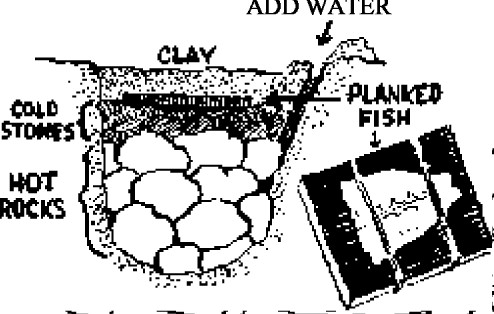By Ernest Thompson Seton
| For First Class Overnight Camp |
Encourage your Scouts to travel light on their twenty-four-hour camping trip. You may wish to recommend that they catch their own fish, and cook it as suggested by Ernest Thompson Seton.

"I learned this ancient method of cooking without utensils many years ago from a tribe of Indians. I have used it often for cooking various foods, and have always found it to produce tasty food in addition to creating the interest of even old-time woodcrafters.
"Dig a hole two feet deep and one foot wide. Build a fire alongside, and heat about twenty stones, each as big as two fists. Get a board about a foot square (avoid pine and other resinous woods), split your fish, and lash it to the board. For lashing the Indians used vines, grasses, small trailing roots of evergreen trees, beaten inner fibrous bark, and flexible tender twigs.
"When the stones are white hot, (no carbon deposits on them) dump them into the hole until they fill it within six inches of the top, and cover them with a layer of cold stones. Now, turn the board upside down and put the fish on top of the cold stones, and cover the top with clay, well pressed down. At the edge of the pit make a hole with a stick, and into this pour half a bucket of water, and close up the hole. Of all the roaring and rumbling you ever heard short of a volcano, this will be the most surprising. After a maximum of (10 minutes for small fish) half an hour carefully remove the clay and you will find a beautifully planked fish.
Tips
"If you do not have the stones white hot, the fish will not be thoroughly cooked. If you do not have a row of cold stones on top, the hot ones will char the fish, burn the bindings and make the fish taste bitter from the burnt herbage. If you use wood that has resin in it, the fish tastes the same. Meats require a little longer to cook than fish, depending upon their thickness, potatoes require an hour and a half."